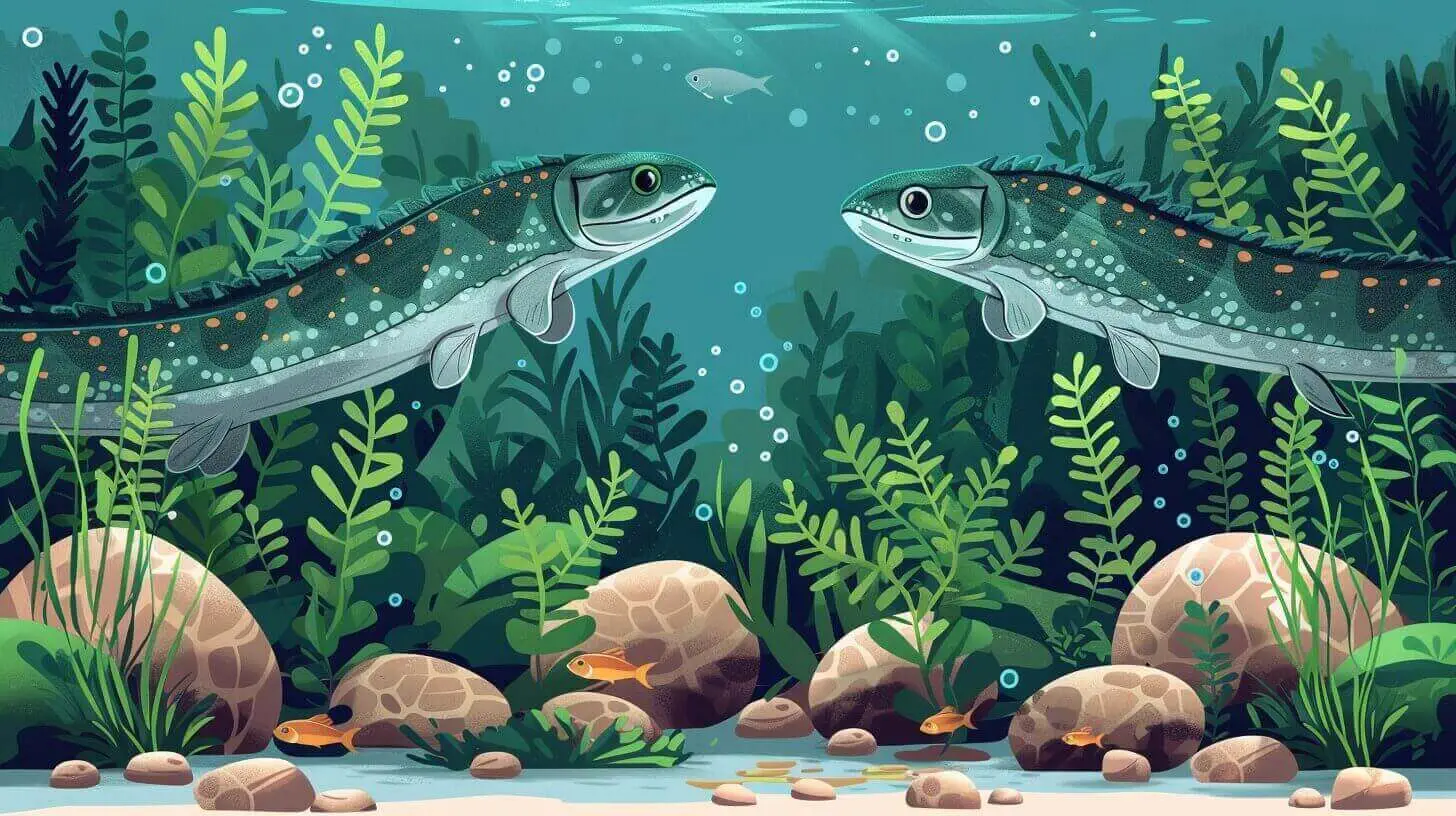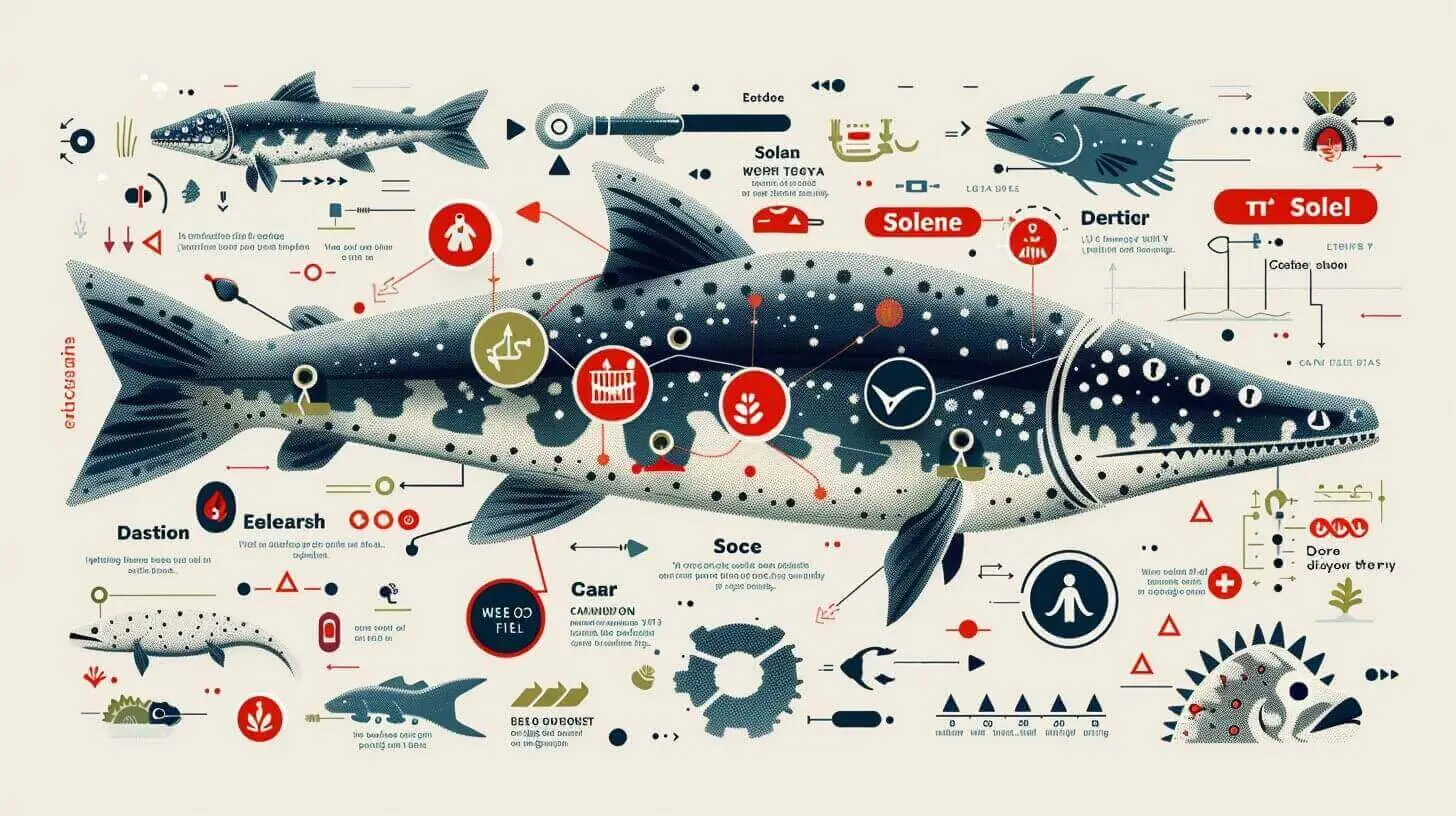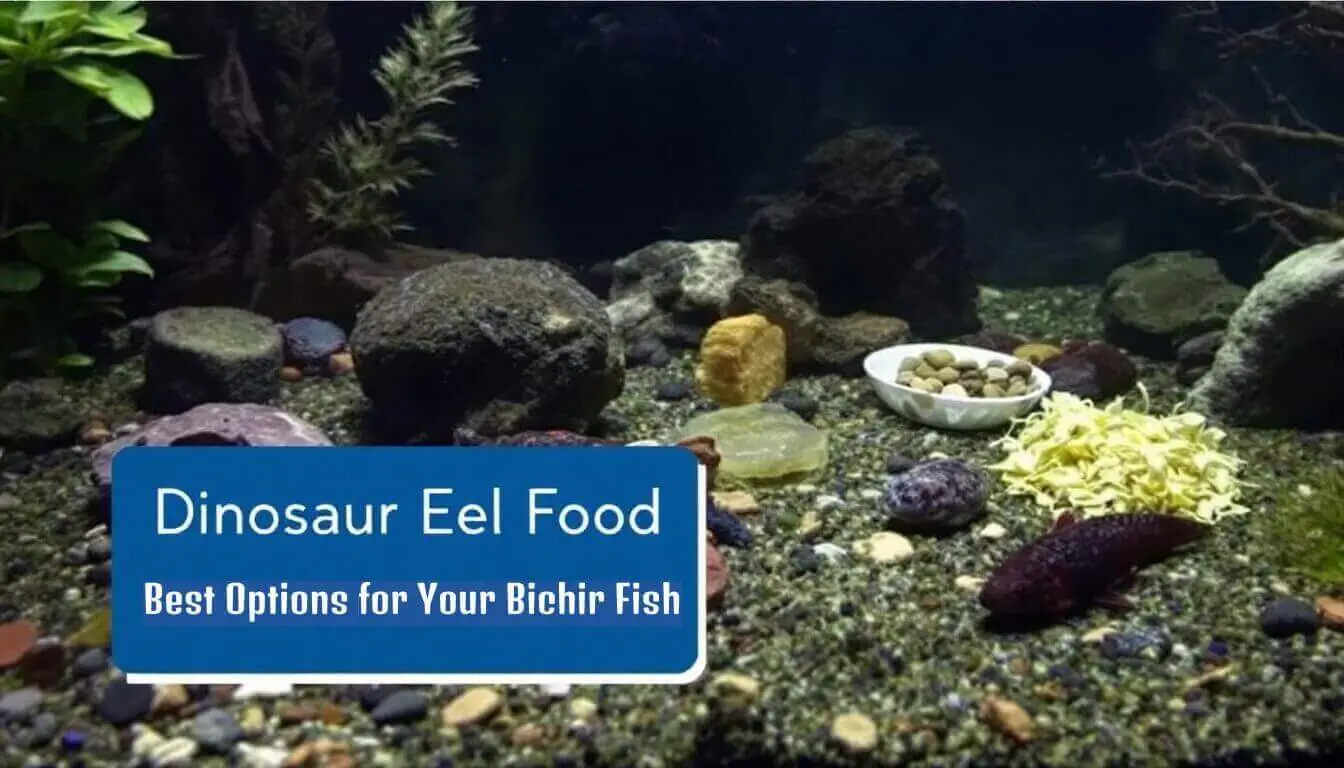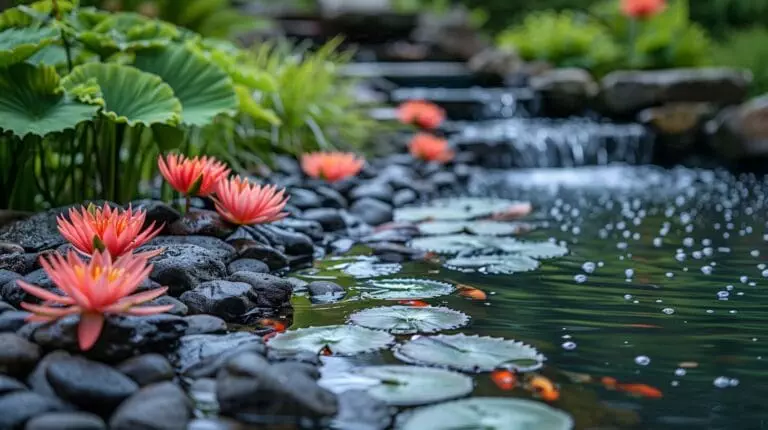Feeding your dinosaur bichir can be tricky. These unique fish need special care and the right food to thrive. Dinosaur eel food is key to keeping your bichir healthy and happy. You’ll learn the best options for your prehistoric pet in this guide.
I’ve spent years caring for bichirs and other aquarium fish. My hands-on experience will help you avoid common feeding mistakes. You’ll discover what foods work best and how to feed your bichir properly.
Get ready to become a bichir feeding pro!
Key Takeaways
- Dinosaur bichirs need protein-rich foods like bloodworms, shrimp, and small fish.
- Feed adult bichirs 2 to 3 times a week, and smaller ones 2 to 3 times daily.
- Commercial options include sinking pellets, freeze-dried krill, and gel foods.
- Homemade foods like fish chunks, beef heart, and earthworm puree boost nutrition.
- Bichirs can live up to 20 years with proper diet and care in a 75°F to 82°F tank.
Understanding Dinosaur Eel Food and Its Importance

Dinosaur eels need the right food to thrive. Your bichir’s diet shapes its health and growth in your tank.
What is Dinosaur Bichir and Its Feeding Habits?
Dinosaur eels, also known as Polypterus senegalus, are unique freshwater fish. They look like a mix of dragons and eels. These fish can grow up to 30 inches long and live for 20 years in tanks. 1 They eat meat and need live or frozen food. Bloodworms, shrimp, and small fish are their favorites.
Bichirs have poor eyesight but a great sense of smell. They use this to find food in the water. These fish are bottom feeders and like to search for meals near the tank floor. You’ll often see them sniffing around plants and decorations for tasty bites.
Nutritional Requirements for Polypterus Senegalus
Polypterus senegalus, or dinosaur eels, need a protein-rich diet. 2 These fish thrive on live or frozen foods like bloodworms, shrimp, and small fish. Smaller bichirs can eat mosquito larvae and vitamin-enriched brine shrimp. Larger specimens enjoy earthworms and mussels too.
Feeding your bichir the right food is key to its health. Avoid typical fish flakes – they’re not good for these carnivores. Instead, offer a mix of meaty foods 2 to 3 times a week. Watch your bichir eat to make sure it gets enough food. This helps prevent health issues and keeps your fish happy.
A well-fed bichir is a healthy bichir.
The Role of Bottom Feeders in the Community Tank
Bottom feeders play a key role in your community tank. These fish, like the dinosaur bichir, clean up leftover food and waste from the tank floor. They help keep your aquarium clean and balanced.
Bichirs, as bottom dwellers, add interest to the lower levels of your tank. They’re not just cleaners – they’re fascinating to watch as they scavenge for food.
Your bichir will eat a variety of foods from the tank bottom. They love meaty options like shrimp, fish, and worms. You can feed them pellets or sticks made for bottom feeders. Cichlid pellets work well too.
For a treat, offer freeze-dried or frozen foods. These hardy fish will help maintain your tank while being an exciting addition to your aquatic community.
Best Food Options for Your Dinosaur Bichir

Feeding your dinosaur bichir the right food is key. Let’s explore the best options to keep your fish healthy and happy. Feeding your dinosaur bichir the right food is key. Let’s explore the best options to keep your fish healthy and happy. These freshwater predators thrive on a diet of high-quality pellets, frozen foods like bloodworms, and occasional live treats such as shrimp or small feeder fish. If you’re wondering “what do gar fish eat,” their preferences are somewhat similar, as they too enjoy meaty foods like fish and crustaceans. Offering a varied diet ensures your bichir stays nutritionally balanced and engaged during feeding time.
Best Bottom Feeders for a Balanced Diet
Dinosaur bichirs need a varied diet to stay healthy. 4 Here are the best bottom feeders for a balanced diet:
- Bloodworms: Rich in protein, these are a favorite treat for many bichirs.
- Beefheart: This high-protein food helps bichirs grow strong and healthy.
- Silversides: Small fish that bichirs can catch, mimicking their natural hunting behavior.
- Home-grown Guppies: Offer live prey for your bichir to chase and eat.
- Ghost Shrimp: Another live food option that bichirs enjoy hunting.
- Grass Shrimp: Live prey that stimulates natural feeding instincts.
- Flakes: Some bichirs will eat flakes, adding variety to their diet.
- Freeze-dried Foods: These offer convenience while still providing good nutrition.
Recommended Commercial Diets for Bichir Fish
Commercial diets offer a balanced nutrition for your bichir fish. Here are top options to keep your aquatic friend healthy:
- Omega One Shrimp Pellets: These sink to the bottom, perfect for bichirs. They’re packed with protein and omega-3 fatty acids.
- Hikari Sinking Carnivore Pellets: Made for meat-eaters, these pellets are rich in fish and krill meal.
- Fluval Bug Bites: These pellets contain insect larvae, matching a bichir’s natural diet.
- Repashy Meat Pie: A gel food you can make at home, full of whole fish and shrimp.
- Tetra JumboKrill: Freeze-dried krill offer a tasty treat high in protein and color-enhancing nutrients.
- New Life Spectrum Thera+A: These pellets have garlic for immune support and algae for vitamins.
- Northfin Carnivore Pellets: Made with whole fish and krill, these pellets are easy to digest.
- Zoo Med Plankton Banquet Blocks: Time-release blocks that slowly dispense food for grazing.
Homemade Food Options for a Nutritional Boost
Commercial diets offer convenience, but homemade options can boost your bichir’s nutrition. You can create tasty meals that mimic their natural diet. Here’s a list of homemade food options for your dinosaur bichir:
- Fish fillet chunks: Cut fresh fish into small pieces. This mimics their wild prey and provides protein.
- Beef heart cubes: Dice lean beef heart. It’s rich in nutrients and appeals to carnivorous bichirs.
- Shrimp mix: Blend whole shrimp with vitamins. This creates a nutrient-dense meal bichirs love.
- Earthworm puree: Blend clean earthworms into a smooth paste. It’s packed with protein and easy to eat.
- Squid rings: Cut squid into small rings. These chewy bites exercise your bichir’s jaws.
- Fish egg mixture: Mix fish eggs with gelatin. This protein-rich food supports growth and health.
- Krill paste: Mash frozen krill into a paste. It’s full of omega-3s for skin and fin health.
- Mussel meat: Chop cooked mussels finely. They’re a great source of minerals for your bichir.
How to Properly Feed Dinosaur Bichir in an Aquarium

Feeding your dinosaur bichir right keeps it happy and healthy. Learn how often to feed, what tank mates work best, and how to spot good eating habits… Read on for more tips!
Feeding Frequency and Portion Sizes
Feed your small bichir 2 to 3 times daily. As it grows to 6 to 7 inches, switch to once a day. Larger bichirs need food 2 to 3 times weekly. 3 Give small amounts they can eat in 2 to 3 minutes.
This stops waste and keeps the tank clean. Watch your fish eat. Adjust the amount if they leave food or seem hungry after meals. Proper feeding keeps your bichir healthy and happy in its tank.
Safe Tank Mates for Your Dinosaur Bichir
After setting a feeding schedule, you’ll need to choose the right tank mates. Dinosaur bichirs get along well with certain fish. Cichlids, geos, acara, some Africans, ctenapoma, and butterfly fish make good companions.
These fish can live peacefully with your bichir in a large aquarium. A 120-gallon tank gives enough space for everyone.
Don’t overcrowd the tank. Your bichir needs room to swim and hunt. Pick tank mates that won’t fight over food. This keeps stress low for all fish. Avoid small fish that might become snacks. Your bichir will thrive with the right friends around.
Observing Feeding Behavior and Adjusting Diet
Safe tank mates are crucial, but watching your bichir eat is just as vital. Keep an eye on your dinosaur eel’s feeding habits. You’ll learn a lot about its health and needs. Mix up its diet with frozen bloodworms, live bloodworms, and pellets. This variety ensures proper nutrition.
Your bichir’s behavior during meals tells a story. Does it eat eagerly or seem uninterested? Adjust portions based on what you see. If food sits uneaten, cut back. If your bichir seems hungry, offer more.
Pay attention to how it reacts to different foods. This helps you create the perfect menu for your prehistoric pet.
Common Issues When Feeding Dinosaur Bichir

Feeding your dinosaur bichir can be tricky. Watch for signs of poor eating and health risks from a bad diet.
Signs Your Bichir Is Not Eating Properly
Your bichir may refuse food due to stress or new tank conditions. Look for signs like hiding more, less active swimming, or ignoring food offerings. A healthy bichir should eagerly eat within 1 to 2 days of being introduced to a new tank. If yours hasn’t eaten after 2 days, it’s cause for concern.
Check if your bichir reacts to food at all. Offer varied options like mini cichlid pellets, bloodworms, or small fish pieces. A disinterested bichir may have lost its appetite from poor water quality or aggressive tank mates.
Monitor closely and adjust tank conditions as needed to help your bichir feel safe enough to eat again. 5
Potential Health Risks Associated with Poor Diet
Poor diet can harm your dinosaur bichir’s health. Lack of proper nutrition leads to weak immune systems and slow growth. These fish need a balanced diet rich in protein. Without it, they may get sick often or fail to reach their full size.
Feeding the wrong foods can cause digestive issues in bichirs. Catfish or angelfish pellets don’t meet their needs. This can result in bloating or constipation. Over time, a poor diet may shorten your bichir’s lifespan. Aim for a varied diet with high-quality, species-specific foods to keep your fish healthy.
Solutions to Common Feeding Problems
Feeding issues can stress out your dinosaur bichir. Here are some fixes for common problems:
- Picky eaters: Offer a mix of foods. Try frozen bloodworms, brine shrimp, and small fish chunks.
- Not eating: Check water quality. Clean the tank and do a 25% water change.
- Overfeeding: Give food only once a day. Remove uneaten food after 10 minutes.
- Competition: Feed at night when bichirs are active. Use a turkey baster to target-feed shy fish.
- Nutritional gaps: Rotate foods weekly. Include both meaty and plant-based options.
- Choking hazards: Cut large food into bite-sized pieces. Avoid hard pellets for young bichirs.
- Aggression during meals: Space out feeding spots. Use multiple dishes to reduce fights.
- Lethargy at feeding time: Boost oxygen levels. Add an air stone or increase surface agitation.
- Refusal of dry foods: Soak pellets in tank water first. Mix with frozen foods to entice eating.
- Constipation: Fast your bichir for a day. Then offer high-fiber foods like daphnia or blanched spinach.
Ensuring a Healthy Diet for Your Dinosaur Bichir

A healthy diet keeps your dinosaur bichir happy and strong. Feed them a mix of foods and watch how they eat to make sure they’re doing well.
Recap of the Best Food Options and Feeding Strategies
Bichirs love live or frozen foods. Shrimp, small fish, mussels, and worms top their menu. For smaller bichirs, try mosquito larvae and bloodworms. Feed them at night when they’re most active.
Spread food around the tank so everyone gets a bite. These slow eaters need time, so be patient. Stick to a mix of proteins for a balanced diet. Frozen foods work great and are easy to store.
Live foods add excitement but require more work. Commercial pellets can round out their meals. Aim for 2 to 3 feedings per week. 3 Watch your bichir eat to ensure they’re getting enough.
Long-Term Care and Maintenance of Your Bichir Fish
Your bichir fish needs proper care to live up to 20 years. Keep the tank at 75°F to 82°F and pH 6.2 to 7.8. 2 Change 25% of the water weekly. Feed a high-protein diet with bloodworms, shrimp, and small fish.
Watch for signs of illness like loss of appetite or unusual behavior. Clean the tank and check equipment regularly. Provide hiding spots and a sandy bottom for comfort. Your bichir will thrive with consistent care and a healthy environment.
Next, we’ll explore future trends in fish nutrition for aquarium enthusiasts.
Future Trends in Fish Nutrition for the Aquarium Hobby
Fish food is changing fast. New types of food will soon hit the market. These foods will have more nutrients and be easier to digest. They’ll help fish grow better and stay healthy longer. Some new foods might even boost fish colors. 6
Tech is making fish food better too. Smart feeders will give fish the right amount of food at the right time. This means less waste and healthier fish. Also, more people are making their own fish food at home.
They use fresh ingredients like worms and shrimp. This trend will keep growing as folks want the best for their fish.
Conclusion
Feeding your dinosaur bichir right keeps it healthy and happy. Pick high-protein foods like worms, shrimp, and small fish. Watch how much you give and how often you feed. Keep the tank clean and check water quality often.
With proper care, your bichir can live up to 20 years as a unique pet.
FAQs
1. What do dinosaur bichirs eat?
Dinosaur bichirs are meat-eaters. They like freeze-dry foods, smaller fish, and other meaty treats. These fish have big appetites and need a lot of food to stay healthy.
2. How often should I feed my bichir?
Feed your bichir once or twice a day. Give them only what they can eat in a few minutes. Don’t overfeed – it’s bad for the water and the fish.
3. Can bichirs eat plant matter?
No, bichirs are not plant-eaters. They need meat to thrive. In the wild, they hunt small fish and other water animals. In tanks, they need similar foods.
4. What size food is best for bichirs?
The food size depends on your bichir’s size. Smaller bichirs need smaller bites. Larger ones can handle bigger pieces. Always make sure the food fits in their mouth.
5. Are there any foods I should avoid giving my bichir?
Don’t give your bichir foods meant for plant-eating fish. Avoid human foods too. Stick to fish foods made for meat-eating fish like bichirs.
6. How do I know if my bichir is eating enough?
A healthy bichir looks active and alert. Their belly should be slightly round, not sunken. If they’re not eating, check the water quality and temp. Bichirs like warm, clean water.
References
- ^ https://www.webmd.com/pets/what-to-know-bichir
- ^ https://www.tropicalaquarium.co.za/threads/care-sheet-dinosaur-bichir-polypterus-senegalus.34044/
- ^ https://www.fishforums.net/threads/an-illustrated-article-to-the-bichir-folio-1.475855/
- ^ https://www.monsterfishkeepers.com/forums/threads/what-do-you-feed-your-bichirs.65239/
- ^ https://www.monsterfishkeepers.com/forums/threads/if-your-polypterus-wont-eat.159825/
- ^ https://www.linkedin.com/pulse/emerging-trends-aquarium-fish-feed-market-global-outlook-future-qu77f






